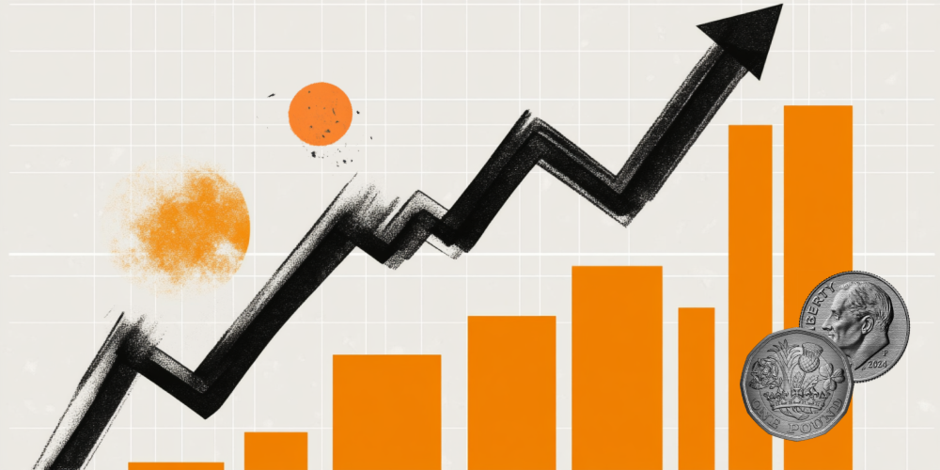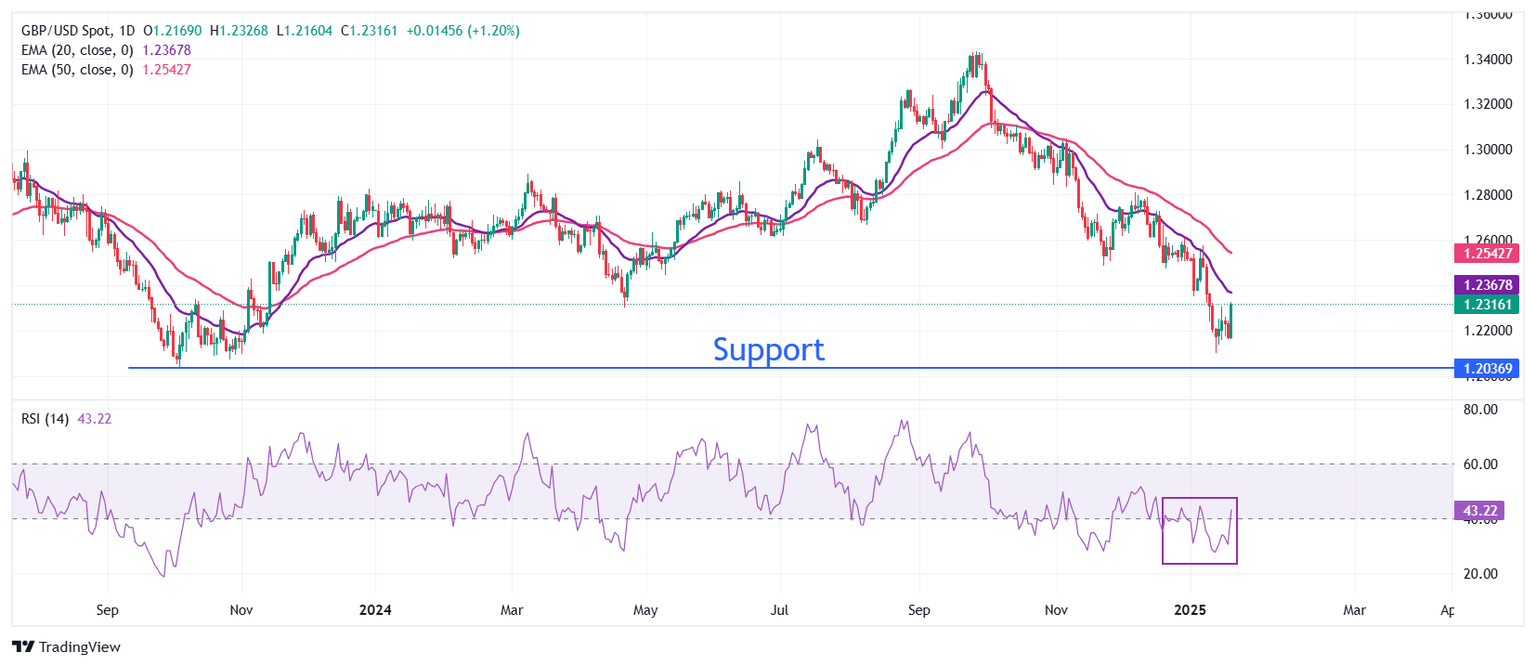Pound Sterling rallies against USD as Trump's memo lacks explicit tariff plans
- The Pound Sterling outperforms its major peers as soft UK data weighs on gilt yields.
- Market experts project a 100 bps interest rate reduction by the BoE this year.
- The risk profile turns favorable for risky assets as Trump's presidential memo lacks a call for immediate tariff imposition

The Pound Sterling (GBP) surges to near 1.2320 against the US Dollar (USD) in Monday’s North American Session. The GBP/USD pair strengthens as the US Dollar nosedive soon after reports from the Wall Street Journal (WSJ) showed that there won't be tariff hikes on the first day of President Donald Trump at the White House. The US Dollar Index (DXY), which tracks the Greenback’s value against six major currencies, plummets to near 108.30.
According to the WSJ, the presidential memo directs federal agencies to study trade policies and evaluate US trade relationships with China and America’s continental neighbors—but stops short of imposing new tariffs on his first day in office. Market participants feared that Trump would be ready with the tariff document that would state the percentage increase in export charges for each nation. Also, the memo highlights China, Canada, and Mexico only.
However, the broader outlook for the US Dollar remains firm as investors expect Trump to announce tariff hikes, sooner or later. His economic policies, including lower taxes, will be pro-growth and inflationary for the United States (US) economy.
The US economic calendar has little to offer this week except for the S&P Global preliminary Purchasing Managers Index (PMI) data for January, which will be published on Friday. Until then, the Greenback will be influenced by market expectations for the Federal Reserve’s (Fed) monetary policy outlook for the entire year.
According to the CME FedWatch tool, traders are pricing in more than one 25 bps interest rate cut this year, seeing the first in the June meeting.
Daily digest market movers: Pound Sterling gains as UK yields slide on fresh acceleration in BoE dovish bets
- The Pound Sterling bounces back against its major peers at the start of the week. Gains in the British currency are driven by a further advancement in demand for United Kingdom (UK) gilts due to weak UK Retail Sales data for December.
- A strong buying interest for UK gilts has weighed heavily on the government’s borrowing costs, pushing 30-year yields further lower to near 5.20% from its more-than-26-year high of 5.47% recorded on January 13. An unexpected decline in the UK Retail Sales data has further accelerated the Bank of England's (BoE) dovish bets. Monthly Retail Sales contracted by 0.3%, while it was expected to grow at a faster rate of 0.4% from a 0.1% increment in November. Analysts at Oxford Economics expect the BoE to cut interest rates by 100 basis points (bps) to 3.75% by the year-end.
- UK gilt yields peaked last week after the release of softer-than-expected Consumer Price Index (CPI) data for December, which increased speculation for the BoE to cut its borrowing rates in the coming policy meeting on February 6.
- It is worth noting that the size of the decline in UK gilt yields is larger than the recovery in the Pound Sterling as weak UK data has boosted dovish BoE bets, which are technically GBP-negative. Higher bets for lower BoE interest rates bode poorly for the Pound Sterling. Meanwhile, UK equity markets have sharply rallied in the last few trading days as Chancellor of the Exchequer Rachel Reeves won’t be forced to raise taxes or cut public spending to fulfill her economic agenda.
- Going forward, the next move in the Pound Sterling will be guided by the UK employment data for the three months ending November, which will be published on Tuesday.
British Pound PRICE Today
The table below shows the percentage change of British Pound (GBP) against listed major currencies today. British Pound was the strongest against the US Dollar.
| USD | EUR | GBP | JPY | CAD | AUD | NZD | CHF | |
|---|---|---|---|---|---|---|---|---|
| USD | -1.46% | -1.24% | -0.51% | -1.38% | -1.50% | -1.52% | -0.65% | |
| EUR | 1.46% | 0.18% | 0.84% | -0.03% | 0.03% | -0.17% | 0.70% | |
| GBP | 1.24% | -0.18% | 0.61% | -0.20% | -0.13% | -0.35% | 0.53% | |
| JPY | 0.51% | -0.84% | -0.61% | -0.85% | -0.93% | -1.10% | -0.30% | |
| CAD | 1.38% | 0.03% | 0.20% | 0.85% | -0.06% | -0.14% | 0.72% | |
| AUD | 1.50% | -0.03% | 0.13% | 0.93% | 0.06% | -0.29% | 0.60% | |
| NZD | 1.52% | 0.17% | 0.35% | 1.10% | 0.14% | 0.29% | 0.69% | |
| CHF | 0.65% | -0.70% | -0.53% | 0.30% | -0.72% | -0.60% | -0.69% |
The heat map shows percentage changes of major currencies against each other. The base currency is picked from the left column, while the quote currency is picked from the top row. For example, if you pick the British Pound from the left column and move along the horizontal line to the US Dollar, the percentage change displayed in the box will represent GBP (base)/USD (quote).
Technical Analysis: Pound Sterling jumps above 1.2300
The Pound Sterling climbs to near 1.2320 against the US Dollar on Monday. The GBP/USD pair recovers Friday's losses and aims to reclaim the 20-day Exponential Moving Average (MEA) around 1.2370.
The 14-day Relative Strength Index (RSI) rebounds above 40.00. A bearish momentum would come to an end if the RSI manages to sustain above 40.00.
Looking down, the pair is expected to find support near the October 2023 low of 1.2050. On the upside, round-level resistance of 1.2400 will act as key resistance.
Risk sentiment FAQs
In the world of financial jargon the two widely used terms “risk-on” and “risk off'' refer to the level of risk that investors are willing to stomach during the period referenced. In a “risk-on” market, investors are optimistic about the future and more willing to buy risky assets. In a “risk-off” market investors start to ‘play it safe’ because they are worried about the future, and therefore buy less risky assets that are more certain of bringing a return, even if it is relatively modest.
Typically, during periods of “risk-on”, stock markets will rise, most commodities – except Gold – will also gain in value, since they benefit from a positive growth outlook. The currencies of nations that are heavy commodity exporters strengthen because of increased demand, and Cryptocurrencies rise. In a “risk-off” market, Bonds go up – especially major government Bonds – Gold shines, and safe-haven currencies such as the Japanese Yen, Swiss Franc and US Dollar all benefit.
The Australian Dollar (AUD), the Canadian Dollar (CAD), the New Zealand Dollar (NZD) and minor FX like the Ruble (RUB) and the South African Rand (ZAR), all tend to rise in markets that are “risk-on”. This is because the economies of these currencies are heavily reliant on commodity exports for growth, and commodities tend to rise in price during risk-on periods. This is because investors foresee greater demand for raw materials in the future due to heightened economic activity.
The major currencies that tend to rise during periods of “risk-off” are the US Dollar (USD), the Japanese Yen (JPY) and the Swiss Franc (CHF). The US Dollar, because it is the world’s reserve currency, and because in times of crisis investors buy US government debt, which is seen as safe because the largest economy in the world is unlikely to default. The Yen, from increased demand for Japanese government bonds, because a high proportion are held by domestic investors who are unlikely to dump them – even in a crisis. The Swiss Franc, because strict Swiss banking laws offer investors enhanced capital protection.
Author

Sagar Dua
FXStreet
Sagar Dua is associated with the financial markets from his college days. Along with pursuing post-graduation in Commerce in 2014, he started his markets training with chart analysis.


















